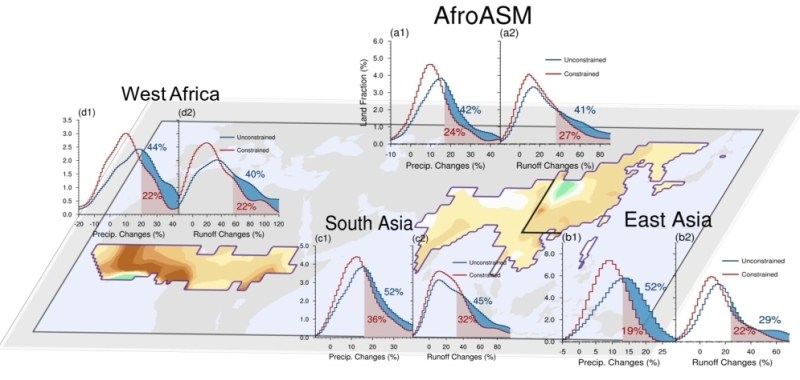中国科学院大气物理研究所大气科学和地球流体力学数值模拟国家重点实验室
State Key Laboratory of Numerical Modeling for Atmospheric Sciences and
Geophysical Fluid Dynamics (LASG)
Institute of Atmospheric Physics, Chinese Academy of Sciences
State Key Laboratory of Numerical Modeling for Atmospheric Sciences and
Geophysical Fluid Dynamics (LASG)
Institute of Atmospheric Physics, Chinese Academy of Sciences

Vol.18/No.18 December 2022
Latest Climate Models Tend to Overestimate Future Afro-Asian Monsoon Rainfall and Runoff
However, a subset of CMIP6 models is "too hot" and the projected warming in response to greenhouse gases is too great. How to tackle the "hot model" problem at the regional scale had previously been unclear.
A research team from the Institute of Atmospheric Physics (IAP) of the Chinese Academy of Sciences (CAS) has revealed that the latest CMIP6 climate models tend to overestimate future Afro-Asian summer monsoon (AfroASM) rainfall and runoff due to present-day biases in warming patterns. By constraining biases, however, the rainfall increase is 70% of the raw projection.
The study was published in Nature Communications on May 10.
The AfroASM includes the West African monsoon, South Asian monsoon, and East Asian monsoon.
The research team identified the leading mode of variability among CMIP6 models in projecting future changes in AfroASM rainfall. They found that projection uncertainty was related to the bias in present-day interhemispheric thermal contrast (ITC). Since large-scale monsoon circulation is driven by ITC due to moist static energy gradients, models with a larger ITC trend over the past thirty years tend to project more precipitation increases.
Since most CMIP6 models tend to overestimate present-day ITC trends, the team corrected the raw projection by designing an emergent constraint technique. The increase in precipitation in the constrained projection is ~70% of the ensemble mean of the CMIP6 models. The area of land with a significant increase in precipitation is ~57% of the raw projection.
The research team further extended its analysis to runoff, which is a mirror of potential water availability. In the constrained projection, ~27% of land area in the AfroASM region will witness a significant increase in potential water availability, which is ~66% of the raw projection. Regionally, the impact of the observational constraint is most pronounced in the West African monsoon region where the fraction of land area with increased water availability is ~55% of the raw projection.
This study provides a solution for tackling the "hot model" problem at regional scales. The emergent constraint technique reported in the study is based on the physical link between a modelled but observable variable in the present day and a projected variable in the future climate system.
"This technique is useful for correcting the bias of CMIP6 models and finally increase the reliability of rainfall projection in the Afro-Asian summer monsoon region. The underlying physical mechanism is the impact of equilibrium climate sensitivity on the interhemispheric thermal contrast in both the historical and future periods," said Dr. ZHOU Tianjun from IAP, corresponding author of the study.
"Smaller increases in precipitation and runoff will likely reduce flooding risk, while also posing a challenge to future water resource management," said CHEN Ziming, a Ph.D. student at the University of the Chinese Academy of Sciences, first author of the study.
The study was supported by the National Key Research and Development Program of China and the National Natural Science Foundation of China.

Spatial distribution of unconstrained and constrained changes in rainfall and runoff. The shadings and percentages in the subplots are the fraction of land area that will experience a significant increase in rainfall (left) and runoff (right) in the unconstrained (blue) and constrained (red) projections. (Image by IAP)
Citation: Ziming Chen, Tianjun Zhou*, Xiaolong Chen, Wenxia Zhang, Lixia Zhang, Mingna Wu, Liwei Zou. 2022. Observationally constrained projection of Afro-Asian monsoon precipitation. Nature Communications. DOI: 10.1038/s41467-022-30106-z
Link:https://doi.org/10.1038/s41467-022-30106-z
Add: No.40, Huayanli, Beichen West Road, Chaoyang District, Beijing P.O. Box 9804, 100029, China
E-mail: lasg_newsletter@lasg.iap.ac.cn
Editors: Chuanyi Wang (wangcy@lasg.iap.ac.cn), Kangjun Chen(ckj@lasg.iap.ac.cn)
E-mail: lasg_newsletter@lasg.iap.ac.cn
Editors: Chuanyi Wang (wangcy@lasg.iap.ac.cn), Kangjun Chen(ckj@lasg.iap.ac.cn)